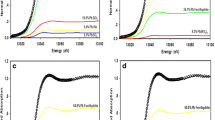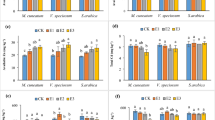Abstract
Silicate (Si) can enhance plant resistance or tolerance to the toxicity of heavy metals. However, it remains unclear whether Si can ameliorate lead (Pb) toxicity in banana (Musa xparadisiaca) roots. In this study, treatment with 800 mg kg−1 Pb decreased both the shoot and root weight of banana seedlings. The amendment of 800 mg kg−1 Si (sodium metasilicate, Na2SiO3·9H2O) to the Pb-contaminated soil enhanced banana biomass at two growth stages significantly. The amendment of 800 mg kg−1 Si significantly increased soil pH and decreased exchangeable Pb, thus reducing soil Pb availability, while Si addition of 100 mg kg−1 did not influence soil pH. Results from Pb fractionation analysis indicated that more Pb were in the form of carbonate and residual-bound fractions in the Si-amended Pb-contaminated soils. The ratio of Pb-bound carbonate to the total Pb tended to increase with increasing growth stages. Treatment with 100 mg kg−1 Si had smaller effects on Pb forms in the Si-amended soils than that of 800 mg kg−1 Si. Pb treatment decreased the xylem sap greatly, but the addition of Si at both levels increased xylem sap and reduced Pb concentration in xylem sap significantly in the Si-amended Pb treatments. The addition of Si increased the activities of POD, SOD, and CAT in banana roots by 14.2% to 72.1% in the Si-amended Pb treatments. The results suggested that Si-enhanced tolerance to Pb toxicity in banana seedlings was associated with Pb immobilization in the soils, the decrease of Pb transport from roots to shoots, and Si-mediated detoxification of Pb in the plants.



Similar content being viewed by others
References
Gupta UC, Gupta SC (1998) Trace element toxicity relationships to crop production and livestock and human health: implications for management. Commun Soil Sci Plant Anal 29:491–1522
Zhang CC, Wang LJ, Nie Q et al (2008) Long-term effects of exogenous silicon on cadmium translocation and toxicity in rice (Oryza sativa L.). Environ Exp Bot 62:300–307
Uveges JL, Corbett AL, Mal TK (2002) Effects of Pb contamination on the growth of Lythrum salicaria. Environ Pollut 120:319–323
Ahmad MSA, Ashraf M, Tabassam Q et al (2011) Lead (Pb)-induced regulation of growth, photosynthesis, and mineral nutrition in maize (Zea mays L.) plants at early growth stages. Biol Trace Elem Res. doi:10.1007/s12011-011-9099-5
Adrano DC (1986) The elements in the terrestrial environment. Springer, New York, pp 1–21, 107–154
Chen HM (1996) Pollution of heavy metals in soil–plant system. Science, Beijing, pp 115–125
Huang YH, Hu Y, Fu ZH (2010) Effect of pollution of Pb and Cd on soil enzyme activities in banana–soil system. J Anhui Agric Sci 38:8092–8093
Liu JJ, Lin SH, Xu PL et al (2009) Effects of exogenous silicon on the activities of antioxidant enzymes and lipid peroxidation in chilling-stressed cucumber leaves. Acta Agric Sinica 8(9):1075–1086
Ashraf M, Rahmatullah M, Ahmad R et al (2010) Amelioration of salt stress in sugarcane by supplying potassium and silicon in hydroponics. Pedosphere 20(2):153–162
Wang YX, Stass A, Horst WJ (2004) Apoplastic binding of aluminum is involved in silicon-induced amelioration of aluminum toxicity in maize. Plant Physiol 136:3762–3770
Singh VP, Tripathi DK, Kumar D et al (2011) Influence of exogenous silicon addition on aluminium tolerance in rice seedlings. Biol Trace Elem Res. doi:10.1007/s12011-011-9118-6
Prabagar S, Hodson MJ, Evans DE (2011) Silicon amelioration of aluminum toxicity and cell death in suspension cultures of Norway spruce (Picea abies (L.) Karst.). Environ Exp Bot 70(2–3):266–276
Liang YC, Wong JWC, Wei L (2005) Silicon-mediated enhancement of cadmium tolerance in maize (Zea mays L.) grown in cadmium contaminated soil. Chemosphere 58:475–483
Vacukik M, Lux A, Luxova M et al (2009) Silicon mitigates cadmium inhibitory effects in young maize plants. Environ Exp Bot 67:52–58
Song A, Li ZJ, Zhang J et al (2009) Silicon-enhanced resistance to cadmium toxicity in Brassica chinensis L. is attributed to Si. J Hazard Mater 172:74–83
Iwasaki K, Maier P, Fecht M et al (2002) Leaf apoplastic silicon enhances manganese tolerance of cowpea (Vigna unguiculata L.). J Plant Physiol 159:167–173
Barbafieri M, Pini R, Ciucci A et al (2011) Field assessment of Pb in contaminated soils and in leaf mustard (Brassica juncea L.): the LIBS technique. Chem Ecol 27:161–169
Ma JF, Higashitani A, Sato K et al (2003) Genotypic variation in silicon concentration in barley grain. Plant Soil 249:383–387
Zhang YK, Han XJ, Chen XL et al (2009) Exogenous nitric oxide on antioxidative system and ATPase activities from tomato seedlings under copper stress. Sci Hortic 123:217–223
Davidson CM, Thomas RP, McVey SE et al (1994) Evaluation of a sequential extraction procedure for the speciation of the speciation of heavy metals in sediments. Anal Chim Acta 291(3):277–286
Singh SP, Tack FM, Verloo MG (1998) Heavy metal fractionation and extractability in dredged sediment derived surface soils. Wat Air Soil Poll 102(3):313–328
Kirkelund GM, Ottosen LM, Villumsen A (2010) Investigations of Cu, Pb and Zn partitioning by sequential extraction in harbour sediments after electrodialytic remediation. Chemosphere 79:997–1002
Yang X, Chen JH, Zhang YL et al (2010) Effects of aging on the fractionation of lead and cadmium in tobacco planting soils. Chin J Tob Sci 16(5):44–49
Okbah MA, Nasr SM, Kasem SM (2011) Fractionation of trace metals (Mn, Zn, Cu, Pb) in red sea sediments, Gulf of Aden, Yemen. Chem Ecol 27(1):81–90
Sharma P, Dubey RS (2005) Lead toxicity in plants. Braz J Plant Physiol 17(1):35–52
Breckle SW (1991) Heavy metal stress in plants. In: Waisel Y, Eshel A, Kafkafi U (eds) Plant roots: the hidden half. Marcel Dekker, New York, pp 121–154
Obroucheva NV, Bystrova EI, Ivanov VB et al (1998) Root growth responses to lead in young maize seedlings. Plant Soil 202:55–61
van Assche F, Clijsters H (1990) Effects of metal on enzyme activity in plants. Plant Cell Environ 13:195–206
Verma S, Dubey RS (2003) Lead toxicity induces lipid peroxidation and alters the activities of antioxidant enzymes in growing rice plants. Plant Sci 164:645–655
Neumann D, ZurNieden U (2001) Silicon and heavy metal tolerance of higher plants. Phytochemistry 56:685–692
Liang YC, Sun WC, Zhu YG et al (2007) Mechanisms of silicon-mediated alleviation of abiotic stresses in higher plants: a review. Environ Poll 147:422–428
Shi XH, Zhang CC, Wang H et al (2005) Effect of Si on the distribution of Cd in rice seedlings. Plant Soil 272:53–60
Hammond KE, Evans DE, Hodson MJ (1995) Aluminum/silicon interactions in barley (Hordeum vulgare L.) seedlings. Plant Soil 173:89–95
Anderson A, Nilsson KO (1974) Influence of lime and soil pH on Cd availability to plants. Ambio Suiza 3:198–200
Tan SK, Lu LL, Yang XE et al (2010) Spatial imaging and speciation of lead in the accumulator plant Sedum alfredii by microscopically focused synchrotron X-ray investigation. Environ Sci Technol 44:5920–5926
Acknowledgements
This research work is jointly supported by the grants from Key Lab of Soil Environment and Pollution Remediation, Institute of Soil Science, Chinese Academy of Sciences; Science Research Foundation of the Key Laboratory of Crop Nutrition and Fertilization of the Ministry of Agriculture, People’s Republic of China (2009–5); National Natural Science Foundation of China (31071847; 30771294); Research Fund for the Doctoral Program of Higher Education of China (20104404110016); and Cultivation Project of Guangdong Province Institute of Higher Education Talents at High Levels.
Author information
Authors and Affiliations
Corresponding author
Rights and permissions
About this article
Cite this article
Li, L., Zheng, C., Fu, Y. et al. Silicate-Mediated Alleviation of Pb Toxicity in Banana Grown in Pb-Contaminated Soil. Biol Trace Elem Res 145, 101–108 (2012). https://doi.org/10.1007/s12011-011-9165-z
Received:
Accepted:
Published:
Issue Date:
DOI: https://doi.org/10.1007/s12011-011-9165-z




